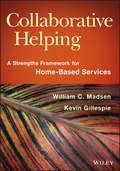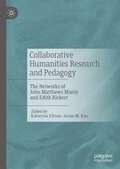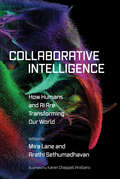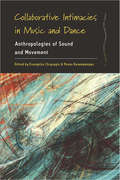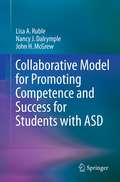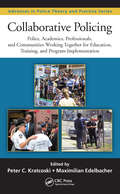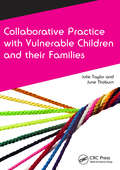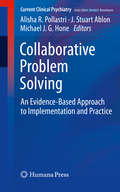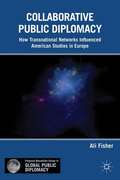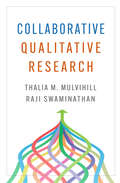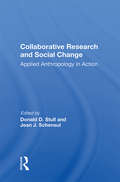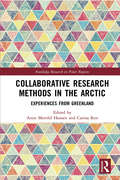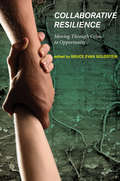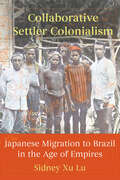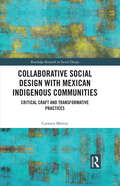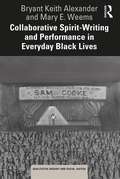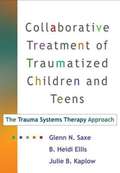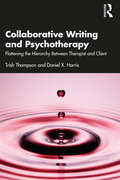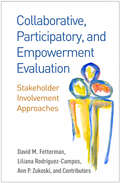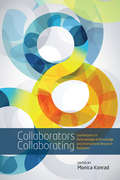- Table View
- List View
Collaborative Helping: A Strengths Framework for Home-Based Services
by William C. Madsen Kevin GillespieAn interdisciplinary framework for sustainable helping through cross-system collaborationThis hands-on resource provides clear, practical guidance for supportive service professionals working in a home-based environment. Drawing on best practices from a range of disciplines, this book provides a clear map for dealing with the complex and often ambiguous situations that arise with individuals and families, with applications extending to supervision and organizational change. Readers gain the advice and insight of real-world frontline helpers, as well as those who receive care, highlighting new ways to approach the work and re-think previous conceptualizations of problems and strengths. Helping efforts are organized around a shared, forward-thinking vision that anticipates obstacles and draws on existing and potential supports in developing a collaborative plan of action.The book begins with stories that illustrate core concepts and context, presenting a number of useful ideas that can reorient behavioral services while outlining a principle-based practice framework to help workers stay grounded and focused. Problems are addressed, and strength-based work is expanded into richer conversations about strengths in the context of intention and purpose, value and belief, hopes, dreams, and commitments. Topics include:Contextual guidance with helping mapsEngaging people and re-thinking problems and strengthsDilemmas in home and community servicesSustainable helping through collaboration and supportA strong collaboration between natural networks, communities, and trained professionals across systems creates an effective helping endeavor. Ensuring sustainability may involve promoting systems change, and building institutional supports for specific supervisory, management, and organizational practices. Collaborative Helping provides a framework for organizing these efforts into a coherent whole, serving the needs of supportive services workers across sectors.
Collaborative Humanities Research and Pedagogy: The Networks of John Matthews Manly and Edith Rickert
by Katherine Ellison Susan M. KimThis edited collection of essays brings together scholars across disciplines who consider the collaborative work of John Matthews Manly and Edith Rickert, philologists, medievalists and early modernists, cryptologists, and education reformers. These pioneers crafted interdisciplinary partnerships as they modeled and advocated for cooperative alliances at every level of their work and in all their academic relationships. Their extensive network of intellectual partnerships made possible groundbreaking projects, from the eight-volume Text of the Canterbury Tales (1940) to the deciphering of the Waberski Cipher, yet, except for their Chaucer work, their many other accomplishments have received little attention. Collaborative Humanities Research and Pedagogy not only surveys the rich range of their work but also emphasizes the transformative intellectual and pedagogical benefits of collaboration.
Collaborative Intelligence: How Humans and AI Are Transforming Our World
by Mira Lane and Arathi SethumadhavanA deep look into the multifaceted landscape of artificial intelligence, considering AI&’s ethical and societal implications and celebrating its diverse and innovative applications.In this edited collection Collaborative Intelligence, Mira Lane and Arathi Sethumadhavan embark on a captivating exploration of artificial intelligence. The book delves deeply into the dynamic interplay between theory and practice, shedding light on the transformative potential and complexities of AI. For practitioners deeply immersed in the world of AI, Lane and Sethumadhavan offer firsthand accounts and insights from technologists, academics, and thought leaders, as well as a series of compelling case studies, ranging from AI's impact on artistry to its role in addressing societal challenges like modern slavery and wildlife conservation.As the global AI market burgeons, this book enables collaboration, knowledge sharing, and interdisciplinary dialogue. It caters not only to the practitioners shaping the AI landscape but also to policymakers striving to navigate the intricate relationship between humans and machines, as well as academics. Divided into two parts, the first half of the book offers readers a comprehensive understanding of AI's historical context, its influence on power dynamics, human-AI interaction, and the critical role of audits in governing AI systems. The second half unfolds a series of eight case studies, unraveling AI&’s impact on fields as varied as healthcare, vehicular safety, conservation, human rights, and the metaverse. Each chapter in this book paints a vivid picture of AI&’s triumphs and challenges, providing a panoramic view of how it is reshaping our world.
Collaborative Intimacies in Music and Dance: Anthropologies of Sound and Movement (Dance and Performance Studies #10)
by Evangelos Chrysagis Panas KarampampasAcross spatial, bodily, and ethical domains, music and dance both emerge from and give rise to intimate collaboration. This theoretically rich collection takes an ethnographic approach to understanding the collective dimension of sound and movement in everyday life, drawing on genres and practices in contexts as diverse as Japanese shakuhachi playing, Peruvian huayno, and the Greek goth scene. Highlighting the sheer physicality of the ethnographic encounter, as well as the forms of sociality that gradually emerge between self and other, each contribution demonstrates how dance and music open up pathways and give shape to life trajectories that are neither predetermined nor teleological, but generative.
Collaborative Model for Promoting Competence and Success for Students with ASD
by John H. Mcgrew Nancy J. Dalrymple Lisa A. RubleRising numbers of young children diagnosed with autism spectrum disorders means more students with ASD entering pre-school and the elementary grades. For these young learners, individualized instruction toward measurable goals is crucial to effective education. The COMPASS program--Collaborative Model for Promoting Competence and Success for Students with Autism Spectrum Disorders--has been developed to improve outcomes for these students in the unique context of their lives. Collaborative Model for Promoting Competence and Success for Students with ASD builds consulting and ASD knowledge competencies while working with families and teachers in a systematic, empirically supported consultation program. The book offers a framework for individualized assessment and program planning based in students' life experiences along with family and teacher input. At the same time, its two-tiered consultation/coaching strategy is designed to minimize the setbacks that occur even in optimal family and classroom situations. Protocols, scripts, forms, and case examples are included for a complete guide to facilitating successful learning. Featured in the text: Theory and rationale behind COMPASS.Self-evaluation tools for assessing core skills and competencies.Guidelines for writing effective Individual Education Programs and the COMPASS Action Plan.Detailed instructions for implementing Action Plans and monitoring progress.Case studies of the COMPASS program in real-life situations. A complete kit of forms, scales, and checklists. Practitioners working with children with ASD, particularly in child and school psychology, special education, rehabilitation, social work, speech pathology, and developmental psychology, will find in Collaborative Model for Promoting Competence and Success for Students with ASD a consultation model that empowers teachers, families, and above all, students.
Collaborative Policing: Police, Academics, Professionals, and Communities Working Together for Education, Training, and Program Implementation (Advances in Police Theory and Practice)
by Peter C. Kratcoski Maximilian Edelbacher"The chapters in this book reveal that police education, training, and practices are now closely tied to collaboration between police, academics, professional practitioners, and community agencies, and such collaboration is described and evaluated." Dilip K. Das, PhD, Founding President, International Police Executive Symposium (IPES) and founding
Collaborative Practice with Vulnerable Children and Their Families (CAIPE Collaborative Practice Series)
by Julie Taylor June ThoburnCollaborative Practice with Vulnerable Children and Their Families focuses on the knowledge and skills needed by professionals who work across disciplines to meet the needs of parents and children experiencing complex difficulties. It establishes the importance of both interprofessional and interagency collaboration. After detailing the characteristics of parents and children who may be in need of specialized services, the authors describe different approaches to service delivery in theory and practice, provide case examples and exercises, and address the developments in interprofessional education for those currently working in the field. They present evidence supporting collaborative practice as a means of achieving better outcomes for vulnerable children and their families, and explore the difficulties in working successfully across agencies and disciplines. A provocative examination focused on the wellbeing of families in crisis and the care they receive, this book: Introduces terms that are used in collaborative practice Details the legal mandate for working with families experiencing complex problems Provides legal definitions of ‘children in need’ and with a right to receive "targeted" services Outlines the circumstances that require court action (family law and criminal law) to protect children from "significant harm" Collaborative Practice with Vulnerable Children and Their Families examines the values and ethical standards shared by all professionals who work together to help at-risk children and their families, and serves as a definitive guide to professionals in social work, nursing, general practice, pediatrics and related professions. A volume in the series CAIPE Collaborative Practice SeriesSeries edited by Hugh Barr and Marion Helme
Collaborative Problem Solving: An Evidence-Based Approach to Implementation and Practice (Current Clinical Psychiatry)
by J. Stuart Ablon Alisha R. Pollastri Michael J.G. HoneThis book is the first to systematically describe the key components necessary to ensure successful implementation of Collaborative Problem Solving (CPS) across mental health settings and non-mental health settings that require behavioral management. This resource is designed by the leading experts in CPS and is focused on the clinical and implementation strategies that have proved most successful within various private and institutional agencies. The book begins by defining the approach before delving into the neurobiological components that are key to understanding this concept. Next, the book covers the best practices for implementation and evaluating outcomes, both in the long and short term. The book concludes with a summary of the concept and recommendations for additional resources, making it an excellent concise guide to this cutting edge approach. Collaborative Problem Solving is an excellent resource for psychiatrists, psychologists, social workers, and all medical professionals working to manage troubling behaviors. The text is also valuable for readers interested in public health, education, improved law enforcement strategies, and all stakeholders seeking to implement this approach within their program, organization, and/or system of care.
Collaborative Public Diplomacy
by Ali FisherUsing archival research and recorded interviews, this book charts the development of American Studies in Europe during the early Cold War. It demonstrates how negotiations took place through a network of relationships and draws lessons for public diplomacy in an age when communities are connected through multi-hub, multi-directional networks.
Collaborative Qualitative Research
by Raji Swaminathan Thalia M. MulvihillMeeting a key need for qualitative researchers, this practical book presents tools for creating productive partnerships and managing each phase of a collaborative project. The authors provide guidelines for working across disciplines, status differentials (such as professor and student), and geographical locations. Collaboration within particular qualitative traditions--cross-cultural research, duoethnography, participatory action research, arts-based collaborations, and others--is described and illustrated with exemplars of published studies. Readers learn how to build research teams, formulate research questions, gather and analyze data, and assess how collaborations are working. Ethical questions are highlighted throughout: Who owns collaborative research? Who decides what aspects of the findings should be disseminated? How can inequitable power relations be redressed? Within-chapter "Pedagogical Pathways" sections provide practice exercises and opportunities for reflection.
Collaborative Research And Social Change: Applied Anthropology In Action
by Donald D StullCommunity case studies are basic to anthropology, yet there are relatively few examples in which the promotion of social change has been the explicit goal of the research. The case studies included here are all "natural experiments" that involve long-term community-based research, close collaboration between researchers and representatives of the h
Collaborative Research Methods in the Arctic: Experiences from Greenland (Routledge Research in Polar Regions)
by Anne Merrild HansenThis book addresses the growing demand for collaborative and reflexive scholarly engagement in the Arctic directed at providing relevant insights to tackle local challenges of arctic communities. It examines how arctic research can come to matter in new ways by combining methods and engagement in the field of inquiry in new and meaningful ways. Research informs decisions affecting the futures of arctic communities. Due to its ability to include local concerns and practices, collaborative research could play a greater role in this process. By way of example of how to bring new voices to the fore in research, this edited collection presents experiences of researchers active in collaborative arctic research. It draws multidisciplinary perspectives from a broad range of academics in the fields such as law and medicine over tourism and business studies, planning and development, cultural studies, ethnology and anthropology. It also shares personal experiences of working in Greenland and with Greenlanders, whether communities, businesses and entrepreneurs, public officials and planners, patients or students. Offering useful insights into the current problems of Greenland representative of the arctic region, this book will be beneficial for researchers and scientists involved in arctic research.
Collaborative Research in Theory and Practice: The Poetics of Letting Go
by Kate Pahl Richard Steadman-Jones Lalitha VasudevanThis book invites the reader to think about collaborative research differently. Using the concepts of ‘letting go’ (the recognition that research is always in a state of becoming) and 'poetics’ (using an approach that might interrupt and remake the conventions of research), it envisions collaborative research as a space where relationships are forged with the use of arts-based and multimodal ways of seeing, inquiring and representing ideas. The book's chapters are interwoven with ‘Interludes’ which provide alternative forms to think with and another vantage point from which to regard phenomena, pose a question and seek insights or openings for further inquiry, rather than answers. Altogether, the book celebrates collaboration in complex, exploratory, literary and artistic ways within university and community research.
Collaborative Resilience: Moving Through Crisis to Opportunity
by Bruce Evan GoldsteinCase studies and analyses investigate how collaborative response to crisis can enhance social-ecological resilience and promote community reinvention.Crisis—whether natural disaster, technological failure, economic collapse, or shocking acts of violence—can offer opportunities for collaboration, consensus building, and transformative social change. Communities often experience a surge of collective energy and purpose in the aftermath of crisis. Rather than rely on government and private-sector efforts to deal with crises through prevention and mitigation, we can harness post-crisis forces for recovery and change through innovative collaborative planning.Drawing on recent work in the fields of planning and natural resource management, this book examines a range of efforts to enhance resilience through collaboration, describing communities that have survived and even thrived by building trust and interdependence. These collaborative efforts include environmental assessment methods in Cozumel, Mexico; the governance of a "climate protected community" in the Blackfoot Valley of Montana; fisheries management in Southeast Asia's Mekong region; and the restoration of natural fire regimes in U.S. forests. In addition to describing the many forms that collaboration can take—including consensus processes, learning networks, and truth and reconciliation commissions—the authors argue that collaborative resilience requires redefining the idea of resilience itself. A resilient system is not just discovered through good science; it emerges as a community debates and defines ecological and social features of the system and appropriate scales of activity. Poised between collaborative practice and resilience analysis, collaborative resilience is both a process and an outcome of collective engagement with social-ecological complexity.
Collaborative Settler Colonialism: Japanese Migration to Brazil in the Age of Empires
by Sidney Xu LuA free ebook version of this title is available through Luminos, University of California Press's Open Access publishing program. Visit www.luminosoa.org to learn more. Though Japanese migration to Brazil started only at the turn of the twentieth century, Brazil is now the country with the largest ethnic Japanese population outside Japan. Collaborative Settler Colonialism examines this history as a central chapter of both Brazil's and Japan's processes of nation and empire building, and, crucially, as a convergence of their settler colonial projects. Inspired by American colonialism and the final conquest of the U.S. Western frontier, Brazilian and Japanese empire builders collaborated to bring Japanese migrant workers to Brazil, which had the outcome of simultaneously dispossessing Indigenous Brazilians of their land and furthering the expansion of Japanese land and resource possession abroad. Bringing discourses of Latin American and Japanese settler colonialism into rare dialogue with each other, this book offers new insight into understanding the Japanese empire, the history of immigration in Brazil and Latin America, and the past and present of settler colonialism.
Collaborative Social Design with Mexican Indigenous Communities: Critical Craft and Transformative Practices (Routledge Research in Social Design)
by Carmen MalvarThis book builds on the work of anthropologists, designers, and ethnographers to develop an original methodology and framework for indigenous engagement and designer/non-designer collaboration in the field of social design. Following a collaborative case study conducted over a five-year period between the author, project team, and indigenous artisans in Mexico, the book outlines the practical challenges of design research, including funding, logistics, relationships between designers and communities, failures, successes, and pivots. Social design literature has often focused on introducing important questions to the design research process, but fails to deeply interrogate and demonstrate how these theories inform research projects in action, which can then be open to misinterpretation, bias, and unintended harmful consequences. Centering the indigenous communities, this book provides a detailed and clear example of not just why, but how design and designers can work authentically and responsibly through different approaches and systems. The book examines the specific cultural, epistemological and socio-political history of Mexico as it relates to colonization and indigenous peoples, exploring the systemic influences of globalization and grounding the research in its unique context. It includes field notes, conversations with the indigenous artisan communities, workshops and prototypes to offer unique insight into a detailed, collaborative social design initiative. This book intersects with the growing awareness of the necessity of decolonial approaches to design across the world and will be an important and useful study for academics, students and researchers in social design, sustainable development, cultural studies and anthropology.
Collaborative Society (The MIT Press Essential Knowledge Series)
by Dariusz Jemielniak Aleksandra PrzegalinskaHow networked technology enables the emergence of a new collaborative society. Humans are hard-wired for collaboration, and new technologies of communication act as a super-amplifier of our natural collaborative mindset. This volume in the MIT Press Essential Knowledge series examines the emergence of a new kind of social collaboration enabled by networked technologies. This new collaborative society might be characterized as a series of services and startups that enable peer-to-peer exchanges and interactions though technology. Some believe that the economic aspects of the new collaboration have the potential to make society more equitable; others see collaborative communities based on sharing as a cover for social injustice and user exploitation.The book covers the “sharing economy,” and the hijacking of the term by corporations; different models of peer production, and motivations to participate; collaborative media production and consumption, the definitions of “amateur” and “professional,” and the power of memes; hactivism and social movements, including Anonymous and anti-ACTA protest; collaborative knowledge creation, including citizen science; collaborative self-tracking; and internet-mediated social relations, as seen in the use of Instagram, Snapchat, and Tinder. Finally, the book considers the future of these collaborative tendencies and the disruptions caused by fake news, bots, and other challenges.
Collaborative Spirit-Writing and Performance in Everyday Black Lives (ISSN)
by Mary E. Weems Bryant Keith AlexanderCollaborative Spirit-Writing and Performance in Everyday Black Lives is about the interconnectedness between collaboration, spirit, and writing. It is also about a dialogic engagement that draws upon shared lived experiences, hopes, and fears of two Black persons: male/female, straight/gay. This book is structured around a series of textual performances, poems, plays, dialogues, calls and responses, and mediations that serve as claim, ground, warrant, qualifier, rebuttal, and backing in an argument about collaborative spirit-writing for social justice. Each entry provides evidence of encounters of possibility, collated between the authors, for ourselves, for readers, and society from a standpoint of individual and collective struggle. The entries in this Black performance diary are at times independent and interdependent, interspliced and interrogative, interanimating and interstitial. They build arguments about collaboration but always emanate from a place of discontent in a caste system, designed through slavery and maintained until today, that positions Black people in relation to white superiority, terror, and perpetual struggle.With particular emphasis on the confluence of Race, Racism, Antiracism, Black Lives Matter, the Trump administration, and the Coronavirus pandemic, this book will appeal to students and scholars in Race studies, performance studies, and those who practice qualitative methods as a new way of seeking Black social justice.
Collaborative Spirit-Writing and Performance in Everyday Black Lives (Qualitative Inquiry and Social Justice)
by Mary E. Weems Bryant Keith AlexanderCollaborative Spirit-Writing and Performance in Everyday Black Lives is about the interconnectedness between collaboration, spirit, and writing. It is also about a dialogic engagement that draws upon shared lived experiences, hopes, and fears of two Black persons: male/female, straight/gay. This book is structured around a series of textual performances, poems, plays, dialogues, calls and responses, and mediations that serve as claim, ground, warrant, qualifier, rebuttal, and backing in an argument about collaborative spirit-writing for social justice. Each entry provides evidence of encounters of possibility, collated between the authors, for ourselves, for readers, and society from a standpoint of individual and collective struggle. The entries in this Black performance diary are at times independent and interdependent, interspliced and interrogative, interanimating and interstitial. They build arguments about collaboration but always emanate from a place of discontent in a caste system, designed through slavery and maintained until today, that positions Black people in relation to white superiority, terror, and perpetual struggle. With particular emphasis on the confluence of Race, Racism, Antiracism, Black Lives Matter, the Trump administration, and the Coronavirus pandemic, this book will appeal to students and scholars in Race studies, performance studies, and those who practice qualitative methods as a new way of seeking Black social justice.
Collaborative Therapy with Multi-Stressed Families, Second Edition
by William C. MadsenThis text and professional resource offers an alternative approach to thinking about and working with "difficult" families. From a nonpathologizing stance, William C. Madsen demonstrates creative ways to help family members shift their relationship to longstanding problems; envision desired lives; and develop more proactive coping strategies. Anyone working with families in crisis, especially in settings where time and resources are scarce, will gain valuable insights and tools from this book.
Collaborative Treatment of Traumatized Children and Teens
by B. Ellis Glenn SaxeFor too many traumatized children and their families, chronic stressors such as poverty, substance abuse, and family or community violence coupled with an overburdened care system pose seemingly insurmountable barriers to treatment. This empowering book provides a user-friendly blueprint for making the most of limited resources to help those considered the "toughest cases." Evidence-based strategies are presented for effectively integrating individualized treatment with services at the home, school, and community levels. Written in an accessible, modular format with reproducible forms and step-by-step guidelines for assessment and intervention, the approach is grounded in the latest knowledge about child traumatic stress. It has been recognized as a treatment of choice by state mental health agencies nationwide.
Collaborative Writing and Psychotherapy: Flattening the Hierarchy Between Therapist and Client
by Daniel X. Harris Trish ThompsonCollaborative Writing and Psychotherapy delves into the relationship that develops between client and therapist as they embark on a collaborative autoethnographic writing practice. The book explores the notion that both client and therapist change as a result of engaging in a psychotherapeutic process. The dialogic approach allows both voices to be heard together in the exploration of autoethnographic methods (collaborative autoethnography and dialogic autoethnography) and creative-relational approaches. This book will encourage therapists to be more vulnerable with their own life experiences and how these shape and influence therapeutic encounters with clients. Additional contributions include the expansion of psychotherapeutic literature to explore co-creative (creative relational) methods, and to expand autoethnographic scholarship to include psychotherapy narratives. Finally, the book offers ideas to therapists who might want to develop the ‘fellow traveller’ aspect of their professional identity, either in working directly with clients, or as part of their reflective practice. This book will be suitable for therapists and scholars looking to explore the use of qualitative, autoethnographic and narrative methods in research and practice.
Collaborative, Participatory, and Empowerment Evaluation: Stakeholder Involvement Approaches
by David M. Fetterman And Contributors Liliana Rodríguez-Campos Ann P. ZukoskiFrom pioneering leaders in the field, this is the first book to provide a solid foundation for three major stakeholder involvement approaches: collaborative, participatory, and empowerment evaluation. Highlighting differences among the approaches, the authors focus on the role of the evaluator, who may be in charge of the evaluation, share control, or serve as a "critical friend," leaving stakeholders in control. Practitioners are guided to select and implement the most appropriate framework for the purpose and scope of a given evaluation and the needs of community members and funders. For each approach, a chapter on essential features is followed by two chapters presenting actual sample evaluations--for example, early childhood and community health initiatives, an aquarium, a project with Google, and more. The concluding chapter discusses similarities and circumstances in which the approaches can be combined.
Collaborators Collaborating
by Monica KonradAs bio-capital in the form of medical knowledge, skills and investments moves with greater frequency from its origin in First World industrialized settings to resource-poor communities with weak or little infrastructure, countries with emerging economies are starting to expand new indigenous science bases of their own. The case studies here, from the UK, West Africa, Sri Lanka, Papua New Guinea, Latin America and elsewhere, explore the forms of collaborative knowledge relations in play and the effects of ethics review and legal systems on local communities, and also demonstrate how anthropologically-informed insights may hope to influence key policy debates. Questions of governance in science and technology, as well as ethical issues related to bio-innovation, are increasingly being featured as topics of complex resourcing and international debate, and this volume is a much-needed resource for interdisciplinary practitioners and specialists in medical anthropology, social theory, corporate ethics, science and technology studies.
Collapse: How Societies Choose to Fail or Succeed: Revised Edition
by Jared DiamondIn Jared Diamond’s follow-up to the Pulitzer-Prize winning Guns, Germs and Steel, the author explores how climate change, the population explosion and political discord create the conditions for the collapse of civilizationEnvironmental damage, climate change, globalization, rapid population growth, and unwise political choices were all factors in the demise of societies around the world, but some found solutions and persisted. As in Guns, Germs, and Steel, Diamond traces the fundamental pattern of catastrophe, and weaves an all-encompassing global thesis through a series of fascinating historical-cultural narratives. Collapse moves from the Polynesian cultures on Easter Island to the flourishing American civilizations of the Anasazi and the Maya and finally to the doomed Viking colony on Greenland. Similar problems face us today and have already brought disaster to Rwanda and Haiti, even as China and Australia are trying to cope in innovative ways. Despite our own society’s apparently inexhaustible wealth and unrivaled political power, ominous warning signs have begun to emerge even in ecologically robust areas like Montana.Brilliant, illuminating, and immensely absorbing, Collapse is destined to take its place as one of the essential books of our time, raising the urgent question: How can our world best avoid committing ecological suicide?From the Trade Paperback edition.
